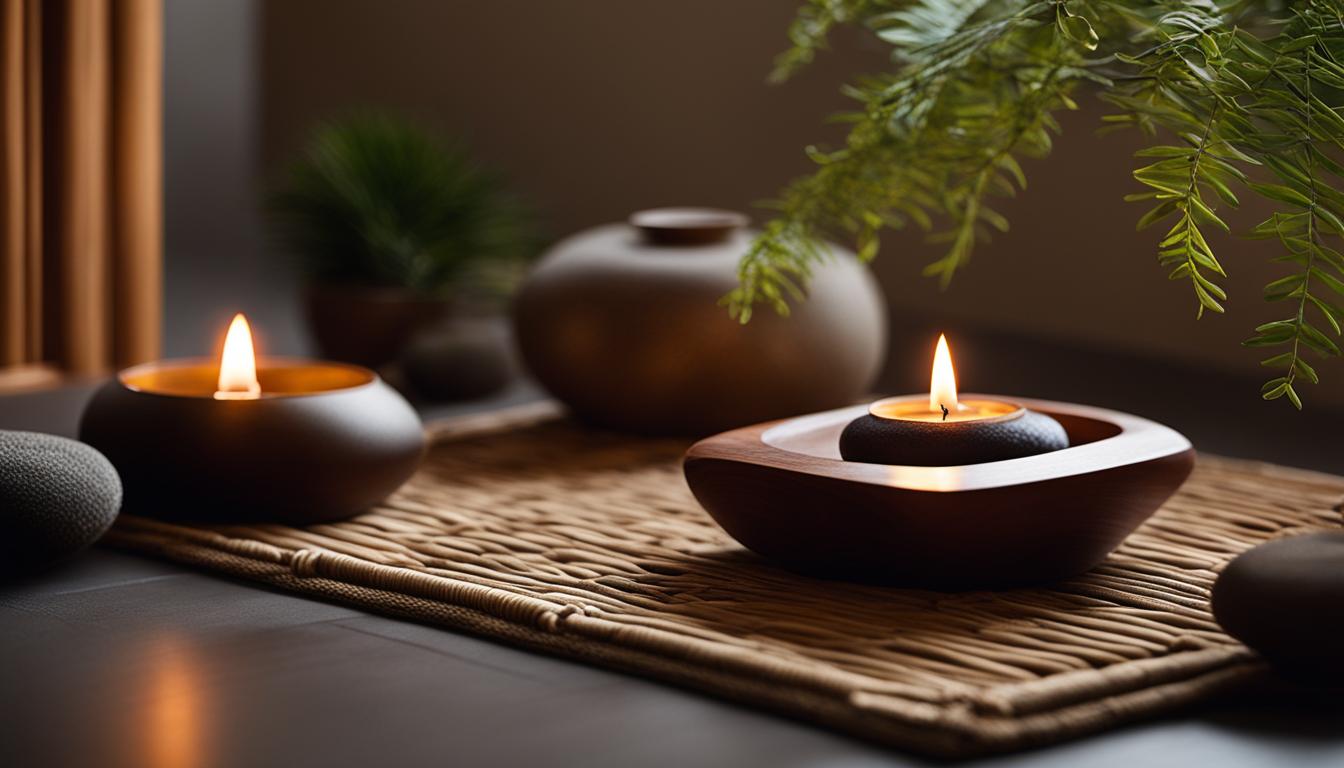Disclosure: This Post Contains Affiliate Links; We earn a commission on purchases.
Creating the perfect meditation playlist can greatly enhance your mindfulness practice. By carefully selecting the right tracks and creating a soothing atmosphere, you can create a harmonious ambiance for deep relaxation and inner peace. In this article, we will explore essential tips and recommendations for meditation playlist creation, helping you curate a collection of mindfulness tracks and calming audio that will transport you to a state of tranquility and focus.
Key Takeaways:
- Create a soothing atmosphere by selecting tracks with serene feelings
- Experiment with different styles to find the perfect noise for your meditation
- Curate a balanced playlist by combining various genres and sounds
- Understand the importance of meditation music in calming the mind
- Explore the essential elements of creating effective meditation compositions
Selecting the Right Style: Locating the Perfect Noise for Meditation
The style of music you choose for your meditation playlist can greatly impact your experience. Some people prefer relaxing and calming sounds, such as classical music or ambient music, to quiet the mind and create a calm environment. Others find that gentle instrumental songs or nature sounds like rain or sea waves enhance their focus and relaxation. It is important to experiment with different styles and find what resonates with you the most, creating a peaceful environment that helps you achieve a state of calmness and peace during your meditation practice.
| Styles of Music | Benefits |
|---|---|
| Classical Music | Creates a serene and contemplative atmosphere |
| Ambient Music | Elevates relaxation and soothes the mind |
| Instrumental Songs | Enhances focus and deepens relaxation |
| Nature Sounds | Brings a sense of harmony and connection with nature |
Creating a Soothing Atmosphere: Choosing Tunes With Serene Feelings
To cultivate a soothing atmosphere for your meditation practice, it is important to carefully select tunes with serene feelings. Look for tracks that have gentle melodies, soft instrumentals, and minimal vocals. Instrumental music, such as ambient, classical, or nature sounds, can be particularly effective in creating a calming environment. Pay attention to the pace of the music as well, as slow, rhythmic beats can help slow down your breathing and heart rate, facilitating a more relaxed state. Ensure that the tracks align with your personal preferences and evoke a sense of tranquility within you.
Incorporating a variety of styles into your meditation playlist can enhance the overall experience. Consider including:
- Soft instrumentals
- Minimal vocals
- Ambient music
- Classic music
- Nature sounds
By combining these elements, you can create a diverse and relaxing atmosphere that promotes inner peace and mindfulness. Experiment with different styles and find what resonates with you the most.
Curating a Balanced Playlist: Combining Various Styles for an Optimum Meditation Experience
For an optimal meditation experience, it is recommended to curate a balanced playlist that incorporates various styles of music. By integrating different genres into your playlist, you can enhance your meditation practice with a diverse range of sounds and vibrations, promoting a deeper state of relaxation and focus.
Start by including traditional meditation music, such as relaxing instrumental tracks or chants, to set a calming tone. These soothing melodies can create a serene atmosphere and help quiet the mind. Consider adding nature sounds like raindrops or waves to further deepen your relaxation and immerse yourself in a peaceful environment.
To introduce a touch of spirituality, incorporate spiritual incantations or mantra recitations. These sacred vocalizations can elevate your meditation experience and foster a sense of connection to the divine. Additionally, integrating ambient music or gentle electronic beats can create a sense of serenity and enhance your focus during the practice.
Experiment with different combinations and adjust the volume levels to find the perfect balance that resonates with you during your meditation sessions. Customizing your playlist according to your personal preferences will ensure an optimum meditation experience tailored to your individual needs.
Remember, the key to curating a balanced playlist is to include a variety of styles that complement one another and create a harmonious flow. Strive for a seamless transition between tracks, allowing each style to enhance the overall atmosphere and energy of your meditation practice.
Examples of Different Styles for a Balanced Meditation Playlist
| Style of Music | Description |
|---|---|
| Relaxing Instrumental Tracks | Instrumental compositions that feature soothing melodies and gentle rhythms, promoting deep relaxation and calmness. |
| Chants | Sacred vocalizations, such as mantras or spiritual incantations, that invoke a sense of spirituality and tranquility. |
| Nature Sounds | Recordings of natural sounds like raindrops, waves, or bird songs, creating a connection to the natural world and enhancing relaxation. |
| Ambient Music | Ethereal and atmospheric music that induces a sense of serenity and allows for deep introspection during meditation. |
| Gentle Electronic Beats | Subtle electronic beats accompanied by soothing melodies, providing a modern twist to meditation music. |

By curating a balanced playlist that includes these various styles of meditation music, you can create an optimum meditation experience that nurtures your mind, body, and soul. Explore the different genres, experiment with combinations, and allow the power of music to enhance your mindfulness practice.
Understanding the Importance of Meditation Music
Meditation music plays a vital role in calming the mind, inducing deep relaxation, and creating a harmonious atmosphere during your meditation practice. By incorporating carefully curated music into your sessions, you can enhance your spiritual journey, unlock new levels of tranquility, and achieve a more profound meditative state.
For centuries, music has been used as a powerful tool to connect with higher states of consciousness and touch our souls. Its soothing melodies and rhythms guide us, helping us find inner peace and quiet our busy minds.
When you listen to meditation music, it acts as a gentle guide, allowing you to focus your attention inward, away from distractions and daily stressors. The calming sounds create a serene environment that encourages relaxation and deepens your meditation experience.
Whether it’s tranquil instrumental tunes, soothing ambient melodies, or meditative chants, the right meditation music can transport you to a state of deep tranquility and inner calm. It serves as a companion on your mindfulness journey, providing a safe space for self-reflection and introspection.
The Role of Meditation Music:
- Calming the mind and reducing anxiety
- Inducing deep relaxation
- Creating a harmonious atmosphere
- Enhancing focus and concentration
- Promoting a sense of inner peace and well-being
When you understand the importance of meditation music, you can harness its power to elevate your mindfulness practice and create a truly transformative experience. Soothing melodies, gentle rhythms, and harmonious compositions become your companions in the path to self-discovery and tranquility.
https://www.youtube.com/watch?v=iDNfjMtFYs8
Essential Elements of Meditation Music
Creating effective meditation music requires a careful blend of essential elements. These elements form the foundation of any remarkable meditation composition. Rhythm and tempo are crucial, as they set the pace and flow of the music, inducing a state of relaxation and harmony. Rhythm provides the heartbeat of the music, guiding the listener into a meditative state. The tempo determines the speed at which the music unfolds, influencing the overall energy and mood of the meditation session.
The melody of meditation music provides the emotional essence. It carries the listener through different states of consciousness and evokes feelings of peace, tranquility, and contemplation. A soothing and captivating melody can transport the mind to a place of deep relaxation and inner stillness.
Harmony adds depth and richness to meditation music. It involves the combination of different musical notes and chords that complement the melody, creating a sense of balance and completeness. Harmonic progression can evoke various emotions and enhance the overall meditative experience, fostering a deeper connection with oneself.
The choice of instrumentation is another essential element in meditation music. Each instrument carries its own unique vibrations and energy, impacting the mood and atmosphere of the meditation session. From traditional instruments like the sitar, flute, or singing bowls, to modern electronic sounds and ambient textures, the choice of instruments can profoundly influence the listener’s journey within.
By understanding these essential elements – rhythm and tempo, melody and harmony, and instrumentation – you can create meditation music that resonates deeply with your soul. These elements work together to create a harmonious blend of sounds that guides you towards a state of deep relaxation, mindfulness, and inner peace.

Step-by-Step Guide to Creating Meditation Music
Creating your own meditation music can be a rewarding and creative process. Follow this step-by-step guide to bring your musical vision to life:
- Set Your Intention: Before diving into the creative process, set your intention for the meditation music you want to create. Consider the emotions and atmosphere you want to evoke in your listeners.
- Choose Your Instruments: Select the instruments that align with your intention and create the desired mood. Whether it’s the soothing sounds of a piano, the ethereal tones of a flute, or the grounding vibrations of a Tibetan singing bowl, choose instruments that resonate with your vision.
- Compose the Melody: Start by crafting a simple melody that captures the essence of your intention. Experiment with different chord progressions and note combinations until you find a melody that resonates with your desired atmosphere.
- Add Harmony and Rhythm: Enhance the melody by layering harmonies and incorporating rhythmic patterns. Experiment with chords, arpeggios, and rhythmic variations to build depth and complexity within your composition.
- Record and Mix: Record each instrument separately, ensuring clarity and quality in each recording. Once all the individual tracks are recorded, mix them together to achieve a balanced and cohesive sound. Pay attention to the volume levels and the overall sonic experience.
By following this step-by-step guide, you can create your own unique meditation music that resonates deeply with both yourself and your listeners. Embrace your creativity, set your intentions, and let the music flow.
Tips for Enhancing Your Meditation Music
If you want to take your meditation music to the next level, consider incorporating these tips and techniques into your compositions:
1. Explore the Power of Nature Sounds
Integrating nature sounds, such as gentle rainstorms, flowing water, or chirping birds, can add an extra layer of tranquility and serenity to your meditation music. These soothing sounds can help you feel more connected to the natural world and create a calming environment for your practice.
2. Harness the Benefits of Binaural Beats
Binaural beats are a unique tool that can enhance your meditation experience by stimulating specific brainwave frequencies. By using different frequencies in each ear, binaural beats have been shown to promote relaxation, focus, and deep meditation. Experiment with different beats and frequencies to find the ones that resonate with you.
3. Explore Different Musical Scales
Consider incorporating different musical scales into your meditation music to create unique moods and evoke specific emotions. The harmonic minor scale, for example, can infuse your compositions with a mystical and introspective quality, while the pentatonic scale can create a sense of calm and tranquility. Explore different scales and see how they impact the overall feel of your music.
4. Add Layers and Textures to Your Compositions
One way to enhance your meditation music is to experiment with layering various instruments and textures. For instance, you can combine soft piano melodies with ethereal synth pads or blend gentle guitar strums with ambient soundscapes. These layered compositions can create a multidimensional and immersive experience for the listener, deepening their connection with the music.
5. Incorporate Sacred Sounds and Chants
Infuse your meditation music with sacred sounds and chants from different spiritual traditions. The repetitive and rhythmic nature of chants can help induce a meditative state and elevate your spiritual practice. Explore chants from traditions such as Buddhism, Hinduism, or Gregorian chants to add a sacred and transcendent quality to your compositions.
6. Experiment with Rhythm and Tempo
The rhythm and tempo of your meditation music can significantly impact the energy and pace of your practice. Slow, steady rhythms can help induce relaxation and a deep sense of calm, while faster tempos can invigorate and energize your meditation. Explore different rhythm patterns and tempos to see how they influence your overall experience.
7. Utilize Technology and Sound Design
Take advantage of technology and sound design techniques to enhance your meditation music. Use effects like reverb and delay to create a sense of spaciousness and depth. Experiment with panning, spatialization, and modulation to create a captivating and immersive sonic environment that envelops the listener.
By incorporating these tips into your meditation music, you can create compositions that truly transport your listeners to a place of deep relaxation, tranquility, and inner peace.
| Tip | Description |
|---|---|
| 1 | Explore the Power of Nature Sounds |
| 2 | Harness the Benefits of Binaural Beats |
| 3 | Explore Different Musical Scales |
| 4 | Add Layers and Textures to Your Compositions |
| 5 | Incorporate Sacred Sounds and Chants |
| 6 | Experiment with Rhythm and Tempo |
| 7 | Utilize Technology and Sound Design |
Conclusion
Congratulations! You have now learned essential tips and recommendations for creating your meditation playlist. By selecting the right style, creating a soothing atmosphere, curating a balanced playlist, and understanding the importance of meditation music, you can enhance your mindfulness practice and create a musical sanctuary for inner peace and relaxation.
Follow the step-by-step guide to create your own meditation music and explore additional tips for enhancing your compositions. Whether you prefer calming sounds, gentle melodies, or ambient music, let the power of meditation music guide you on a blissful journey of self-discovery and tranquility. Embrace the transformative potential of music as it harmonizes with your meditation practice, helping you unlock new levels of mindfulness and spiritual connection.
By incorporating carefully chosen tracks, cultivating a serene environment, and balancing different styles, you can create a personalized meditation playlist that resonates deeply with your soul. Remember to set your intention, choose instruments that resonate with your energy, compose melodies that evoke emotions, add harmonies and rhythms that flow seamlessly, and record and mix your music to perfection.
Create a sacred space with your meditation music, allowing it to be a companion in your journey towards inner peace and self-realization. Let the gentle vibrations and frequencies guide you towards moments of deep relaxation and profound insight. With the power of meditation music, you can unlock the full potential of your mindfulness practice and embark on a path of tranquility, balance, and self-discovery.
Ryan Conlon is a passionate advocate for mindfulness and meditation, dedicated to helping others discover the transformative power of these practices in their lives. As the founder of Daily Meditation, Ryan’s mission is to provide a sanctuary for individuals seeking peace, clarity, and well-being amidst the chaos of modern life. With a background in psychology and years of personal experience with meditation, Ryan brings a wealth of knowledge and insight to his work. Through Daily Meditation, he shares practical guidance, inspirational content, and expert resources to support others on their journey toward greater mindfulness, resilience, and inner peace.
Subscribe to Our Newsletter

















